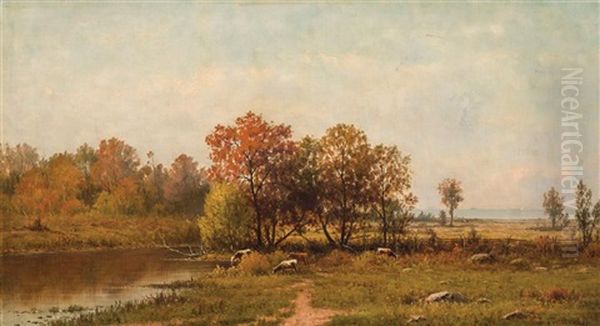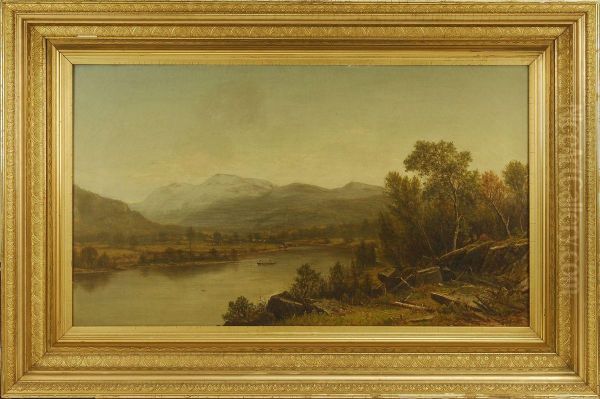Introduction: An Artist of the American Scene
Charles Wilson Knapp stands as a noteworthy figure among the ranks of nineteenth-century American landscape painters. Born in the historic city of Philadelphia in 1823, Knapp dedicated his artistic life to capturing the serene beauty and burgeoning rural character of the American Northeast. His lifespan, concluding in his birth city in 1900, encompassed a period of profound transformation in American art and society. Primarily associated with the later phase of the Hudson River School, Knapp developed a distinct voice, focusing on the settled, pastoral landscapes rather than the untamed wilderness that captivated some of his contemporaries. His works serve as quiet celebrations of agrarian life and the gentle majesty of nature found along the rivers and coastlines from Pennsylvania to New Hampshire.
Philadelphia Roots and Artistic Emergence
Philadelphia, the city of Knapp's birth and death, was a significant cultural and artistic center in the 19th century. Home to the Pennsylvania Academy of the Fine Arts (PAFA), founded in 1805, the city fostered a rich environment for aspiring artists. While specific records detailing Knapp's formal training are scarce, it is highly probable that he was exposed to the city's artistic currents and perhaps benefited from its institutions or studied with local painters. His emergence as a professional artist coincided with the flourishing of landscape painting as a dominant genre in American art, a movement deeply intertwined with national identity and a growing appreciation for the continent's natural splendors. Knapp's decision to specialize in landscape suggests an alignment with the prevailing artistic sentiments of his time.
The Hudson River School Context
To fully appreciate Charles Wilson Knapp's contribution, one must understand the artistic milieu he inhabited, particularly the Hudson River School. This was not a formal institution but America's first true school of landscape painting, emerging in the 1820s and flourishing through the 1870s. Its founding figures, like Thomas Cole and Asher B. Durand, championed the direct observation of nature combined with a Romantic sensibility. They saw the American landscape, particularly the Hudson River Valley and surrounding areas like the Catskills and White Mountains, as a source of national pride and spiritual revelation, a unique alternative to European scenery.

The first generation of Hudson River School painters often imbued their works with allegorical or moral meaning, depicting nature as both sublime and pastoral. Artists like Cole explored themes of wilderness versus civilization. Durand, in contrast, advocated for meticulous, truthful renderings of nature, influencing many who followed. Their efforts established landscape painting as a respected and popular genre in the United States, reflecting the nation's expansion and fascination with its own geography.
Knapp and the Second Generation
Charles Wilson Knapp belongs more comfortably to the second generation of the Hudson River School, which came to prominence around the mid-century. This generation built upon the foundations laid by Cole and Durand but often expanded the geographical scope and stylistic approaches. Figures like Frederic Edwin Church and Albert Bierstadt became famous for their large-scale, dramatic canvases depicting South American jungles, Arctic icebergs, or the Rocky Mountains, emphasizing the sublime and exotic aspects of nature. They achieved immense popularity, reflecting a nation confident in its "Manifest Destiny."
Alongside these painters of the grand panorama were artists who continued the tradition of depicting the more intimate, settled landscapes of the Northeast. This group often included artists associated with Luminism, a style characterized by its subtle handling of light and atmosphere, often featuring calm water and a sense of profound stillness. Key figures associated with this tendency include John Frederick Kensett, Sanford Robinson Gifford, and Martin Johnson Heade. While not strictly categorized as a Luminist, Knapp's work shares the focus on tranquil scenes and careful attention to atmospheric effects found in the works of these contemporaries.
Knapp's Artistic Focus: Pastoral Harmony
Unlike the dramatic vistas favored by Church or Bierstadt, Knapp concentrated on the quieter, more accessible beauty of the established American landscape. His paintings frequently depict the rolling hills, meandering rivers, and working farms of Pennsylvania, New York, and New Hampshire. He seemed particularly drawn to scenes that showed a harmonious coexistence between humanity and nature – cultivated fields bordering woodlands, farmhouses nestled in valleys, cattle grazing near riverbanks. This focus aligns him with the pastoral tradition within the Hudson River School, emphasizing peace, productivity, and the gentle rhythms of rural life.
His subject matter often involved specific, identifiable locations, suggesting careful observation and sketching trips. The areas along the Susquehanna River in Pennsylvania and various sites in New Hampshire's White Mountains appear repeatedly in his known works. This regional focus provides valuable visual documentation of these areas during the latter half of the 19th century, capturing a landscape undergoing gradual change but still retaining much of its agrarian character.
Career and Exhibitions

An artist's reputation during the 19th century was often built through participation in major public exhibitions. Charles Wilson Knapp actively sought visibility for his work, exhibiting at prominent venues. Records show his participation in exhibitions at the prestigious National Academy of Design in New York City. Founded in 1825, the National Academy was a central institution in the American art world, providing exhibition opportunities and training, and electing esteemed artists as Academicians. Exhibiting there placed Knapp alongside the leading artists of his day.
Knapp also exhibited his works in Boston, another important cultural hub. His presence in these key exhibition centers indicates his engagement with the professional art world and his desire to reach audiences and patrons beyond his native Philadelphia. These exhibitions would have exposed his work to critics, collectors, and fellow artists, contributing to his recognition as a competent and appealing landscape painter within the Hudson River School tradition. Other artists frequently exhibiting at the NAD during Knapp's active years included figures like Jervis McEntee, Worthington Whittredge, and Sanford Robinson Gifford, painters whose work often shared Knapp's affinity for detailed, atmospheric landscapes.
Signature Style and Technique
Knapp's paintings are characterized by their detailed realism, a hallmark of the Hudson River School. He rendered trees, foliage, water, and rock formations with considerable care and accuracy, demonstrating a keen observational skill. His compositions are typically well-balanced and harmonious, often employing established landscape conventions like framing elements (trees at the sides) and leading lines (rivers or paths) to draw the viewer into the scene.
His handling of light is often subtle and effective, contributing to the tranquil mood prevalent in his work. While perhaps not as overtly dramatic as the light effects in Luminist masterpieces by artists like Fitz Henry Lane or Kensett, Knapp demonstrated sensitivity to atmospheric conditions, capturing the soft glow of afternoon sun or the hazy light of a summer day. His color palette tends towards naturalistic greens, blues, and earth tones, reinforcing the sense of realism and fidelity to the observed scene. The overall impression is one of serenity, order, and a deep appreciation for the quiet beauty of the American countryside.
Representative Work: View of the Susquehanna River
Among Knapp's most recognized works is View of the Susquehanna River, typically dated to the period between 1860 and 1870. This painting exemplifies many characteristic features of his art and the Hudson River School tradition at its peak. The work likely depicts a scene in Pennsylvania, showcasing a wide river valley flanked by rolling hills. In the foreground or middle ground, elements of rural life are often present – perhaps a farm, grazing animals, or small figures engaged in agricultural activities.
The composition carefully balances the expanse of the river and sky with the details of the land. The rendering is precise, capturing the textures of foliage, the reflections in the water, and the distant atmospheric perspective. The painting evokes a sense of peace and stability, presenting an idealized yet believable vision of American agrarian life. Created during a period of national turmoil (the Civil War decade), such scenes offered viewers a comforting image of enduring natural beauty and rural virtue. It stands as a testament to Knapp's skill in capturing the specific character of a region while adhering to the broader aesthetic principles of his artistic school.
Other Notable Works and New Hampshire Scenes
Beyond the Susquehanna views, Knapp dedicated significant attention to the landscapes of New Hampshire, particularly the White Mountains region, a popular destination for Hudson River School artists. Several of his known titles reference specific locations there, including Ellsworth Brook, Entrance to Franconia Notch, Nature near Mount Chocorua, Peabody River, Mt. Washington, Saco and Conway Meadows, and Mountain in the Androscoggin Valley. These titles, some documented in publications like New Hampshire Scenery, highlight his exploration of this ruggedly beautiful area.
These New Hampshire paintings likely showcased his ability to handle varied terrain, from river valleys and meadows to mountain passes. Works like Entrance to Franconia Notch would have allowed him to engage with the more sublime aspects of nature, albeit likely rendered with his characteristic sense of order and clarity rather than overwhelming drama. Collectively, these works demonstrate Knapp's commitment to documenting the specific topographies of the regions he visited, contributing to the rich visual record of 19th-century American landscapes produced by the Hudson River School artists.
Later Years and Legacy
Charles Wilson Knapp continued to paint through the later decades of the 19th century. During this period, the dominance of the Hudson River School began to wane as new artistic styles gained prominence. Tonalism, with its emphasis on mood and atmosphere over precise detail (seen in the work of George Inness), and American Impressionism, influenced by French developments, offered different ways of seeing and representing the landscape. Realism, as practiced by artists like Winslow Homer, also shifted focus towards different aspects of American life and nature.
Despite these changing tides, Knapp appears to have remained largely faithful to the Hudson River School aesthetic that had shaped his career. He passed away in Philadelphia in 1900, leaving behind a body of work consistent in its style and subject matter. While he may not have achieved the fame of the leading figures of the Hudson River School like Church or Bierstadt, Knapp holds a secure place as a skilled and dedicated practitioner within the movement.
His legacy lies in his sensitive and detailed portrayals of the American pastoral landscape. His paintings offer valuable glimpses into the rural Northeast during a period of significant national development. They appeal to collectors and enthusiasts of traditional American landscape painting for their technical competence, serene beauty, and earnest depiction of nature. His work serves as a reminder of the depth and breadth of the Hudson River School, which included not only painters of the spectacular wilderness but also chroniclers of the quieter, cultivated corners of the American scene.
Conclusion: A Painter of Quiet Beauty
Charles Wilson Knapp navigated the vibrant American art scene of the 19th century as a dedicated landscape painter. Rooted in the principles of the Hudson River School, he carved out a niche focusing on the pastoral beauty of Pennsylvania, New York, and New Hampshire. His works, characterized by detailed realism, balanced compositions, and a tranquil atmosphere, celebrate the harmonious relationship between humanity and nature in the settled landscapes of the Northeast. While perhaps less dramatic than some of his contemporaries, Knapp's paintings, such as the exemplary View of the Susquehanna River, offer enduring images of rural American life and the specific character of its regional topographies. As a consistent contributor to the Hudson River School's later phase and a diligent exhibitor in major art centers, Charles Wilson Knapp remains a significant figure for understanding the full spectrum of 19th-century American landscape painting. His art provides a quiet yet compelling vision of a nation finding beauty and identity in its own land.